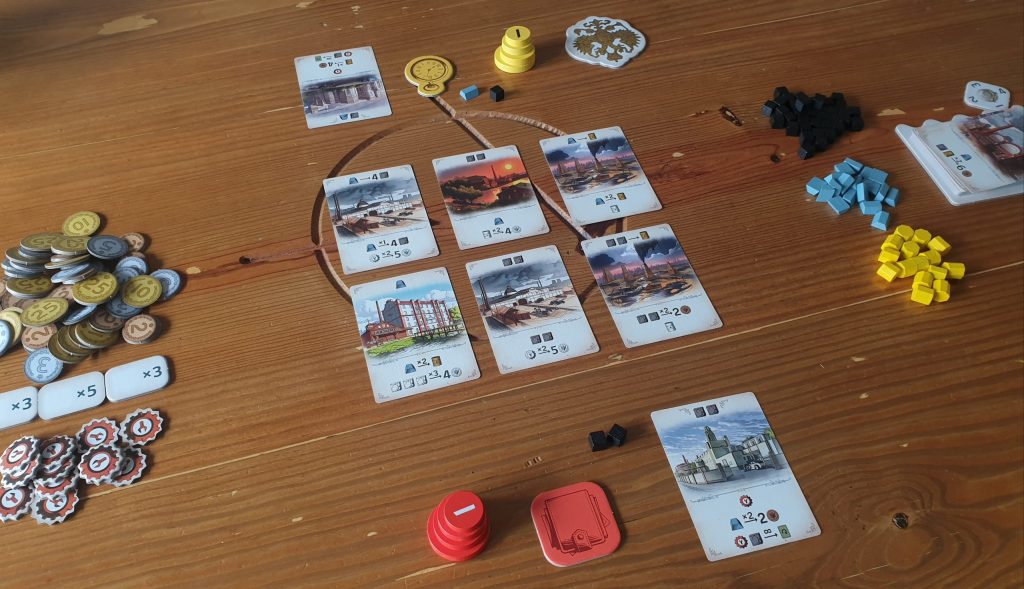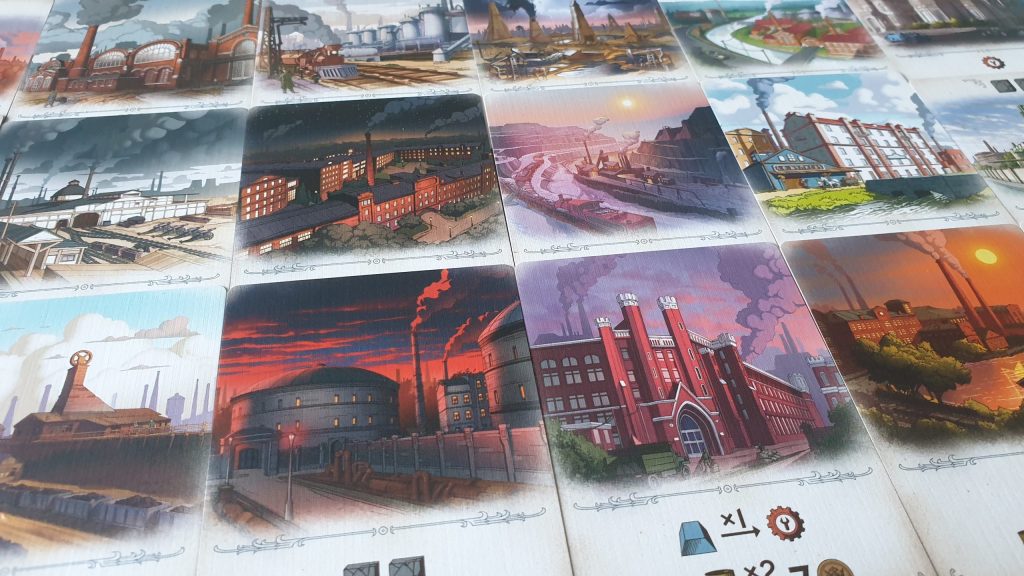Furnace, which you may have seen at the recent Spiel Digital event, is the brand new auction and engine building board game from Hobby World. Designed by Ivan Lashin, the man behind the rather popular Smartphone Inc., the game sees 2 – 4 players become 19th century capitalists, for around 45 minutes. Players will be bidding on companies, sometimes with the aim not to win them, creating a tableau of cards to activate and trying to churn out money. However, will players enjoy the heat of the Furnace? Let’s find out!
Each capitalist receives a unique starting company, 4 bidding discs (numbered 1 – 4) and, if wanting a bit more variety, a unique capitalist ability. The first player is randomly selected and the round tracker is set to 1 out of 4. Rounds are made up of two phases, an auction followed by production. Each round a number of company cards are revealed from the deck, the amount depending on the player count, which are placed into a central line. Beginning with the starting player, players will add one of their bidding discs to a card in the line. There are two restrictions to follow, otherwise the choice is left to the players. Players cannot place a second disc onto a company card and they cannot place a disc of the same value as a disc already on a card.
Once all discs have been placed the results of the auction phase are resolved, with the highest value disc on each winning the card. Before companies are claimed by auction winners compensation is paid. Every company card has a compensation listed at the top. These range from gaining 2 coal to being able to trade iron for oil. Those gaining compensation multiply the denoted benefit by the value on their bid disc. Therefore, if the card has a compensation of 1 iron, a 3 valued disc that didn’t win the auction would gain the owner 3 x 1 iron. When trades of one resource to another are listed this instead denotes how many times the trade can be performed, though all trades are optional. The auction winners then claim their cards but importantly do not gain the compensation.

All players then move to the production phase, where they activate their company cards – including their original unique company and any won at auction. Company cards have basic and upgraded sides. When they are obtained they are always only basic companies. They show at the bottom of the card not only what they produce as a basic company, but what they will also offer in addition as an upgraded company. Each player can activate each of their companies once a round, tapping the card to an angle to show it’s been used.
The aim of all of this is to generate money. From their companies and compensation players will gain resources. These resources (coal, iron and oil) have no value to the player until traded for money, via trade actions listed on their company cards. Company cards, resources and money all carry over from round to round. This allows players to build up an engine of companies that generate resources, upgrade them from cheap coal to expensive oil and then sell them for money. Conversely, players could look to offload cheaper coal and iron at higher rates. At the end of a round players reclaim all of their bidding discs, untap their used companies and prepare for the next round – starting with another auction. At the end of the fourth round players simply add up their money tokens. Whoever has the most is the winner, with ties broken by the most company cards, followed by leftover resources.
When playing with two players there is a dummy player, to keep the auction phase tight. After both players have made a bid in the auction a die is rolled. The number on the die indicates which card the dummy player will bid on, with the lowest valued disc it can. If a dummy player wins a card it is simply removed from play, with the dummy player never producing, being compensated or scoring points. As dummy players go this is a rather light touch, with very little admin added to the experience as a result. It can be a tad more frustrating though to be outbid effectively by a dice roll, than if another player had chosen to bid big on a company.

In the rulebook there are a number of “for your convenience” boxes, each giving useful hints. By far the best one, to get new players into the habit of, is reordering their production cards. This massively helps players visualise a potential production chain. Plus, it allows players to tap cards as they activate the cards from left to right. There is an advanced variant where reordering isn’t allowed. Alas, this stops players’ freedom to find different combos within one game, which is what makes every round of Furnace feel impactful.
Within a game the complexity ramps up. In the first round players will have only a couple of resources coming in from compensation and approximately 3 company cards to activate in the production phase. Over the following rounds more companies will be acquired and this is where the brain burning engine comes into play. By the final round players will have around 10 companies to trigger in any order they wish, with some upgraded and some not. This final production round can be a lot slower, as players try to calculate the optimal ways to tap their engine. Thankfully, by this stage all players will be up to speed enough that everyone can do the production phase simultaneously, saving a good chunk of time.
There are a few ways to make Furnace easier, at least for a learning game. The simplest, so that all players start the same for explaining purposes, is to not include the capitalist cards. These don’t massively change the game but are fun and unique ways that you can break or work around the rules. Each has shown to be effective, though one ability of an additional 2 valued bidding disc is the most obvious power to utilize. 5 capitalist cards are included so you’ll have seen almost all in a 4 player game. Having more could have increased the variety, though the replayability is mostly from the way company cards come out of the deck.

While it slows things down players can perform the production phase one at a time. This gives everyone around the table a chance to see all the steps being taken, and cards tapped, though you’ll probably only need to do this for the first round. The other way that gets around the brain burny fourth round is to cut the game short by only playing 3 rounds. The more rounds you have though the better engines become and the more they can be enjoyed.
A range of artists worked on Furnace, including Sergey Dulin, Marta Ivanova and Ilya Konovalov. Each and everyone one of them should be commended for the stunning look and intuitive UI on the cards. The helpful UI design from the cards extends to other components too. The auction disks are numbered, increasing in size accordingly – which enables players to read the auction line in a glance. Aside from the starting company cards, the artwork used on the cards isn’t unique – with each piece of artwork repeated up to 6 times in the 36 card deck. The upgraded sides of the company cards upgrade the look, as there is more space for the artwork. There is even an extremely subtle change to the image, with things like extra workers depicted. The only real part of the production of Furnace that can be faulted is the box size, as there is a far bit of empty space in the box. The size is probably for consistency in a line of games and for appeal on a store shelf. Still, it could be half the size.
Furnace is the sort of game that is extremely simple to pick up or teach how to play. Only by playing will the amount of choices become apparent, from how to bid through to which order to activate companies during production. There are often times that it is possible to gain more via compensation than actually winning a company card, giving a surprising depth to the auction. For those that are prone to analysis paralysis then there could be too many options, as even fairly decisive players were slowed to a plod by the final production phase. This is never by not knowing what to do, more how to optimally do everything. Furnace is a thinky title, with stunning artwork and intuitive symbology, that many will surely enjoy!
(Editor’s Note: Furnace was provided to us by Hobby World, for the review. Keep an eye out for the game in your local game store, find your local store here.)

